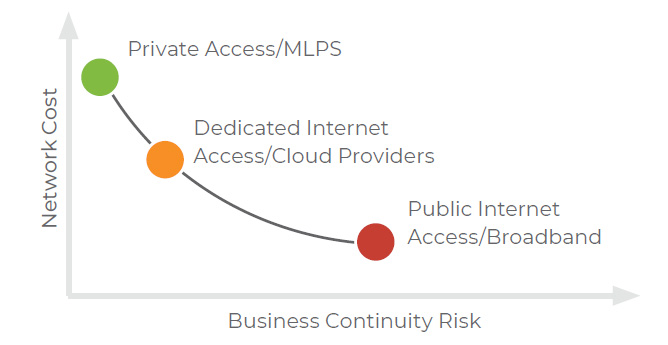SD-WAN for Small, Midsize, and Franchise Businesses: Standalone and Cloud-First Solutions
July 22, 2024

With all the benefits of quick deployment, security, and superior application performance, large enterprises shouldn’t be the only entities tapping into the advantages of SD-WAN. Small and midsize businesses also want and need to deliver always-on digital services while maximizing their IT operational efficiency and profitability.
But traditionally, these businesses have hit a roadblock in reaching SD-WAN — that is, until recently.
In an earlier article, we discussed how SD-WAN solutions are evolving to enable secure connectivity for an expanding number of use cases — from enterprises handling vast numbers of home offices and remote workers to small and midsize businesses with one location or multiple standalone locations. Here, we’ll further explore how this evolution makes SD-WAN (and its many benefits) a reality for these smaller organizations.
Small Businesses are Getting Better Access to SD-WAN
In the past, SD-WAN solutions were primarily available to midsize and large enterprise customers because SD-WAN providers catered to complex IT environments with many locations requiring data exchange. Why ignore the massive market of small businesses needing only internet connections from a single location? Simply put: SD-WAN providers may see scalability and deployment as too complex and too much effort to justify the cost.
To unpack that, it helps to understand how SD-WAN has been used traditionally — a tool to share data between multiple corporate locations, deploying complexly meshed or hub-and-spoke topologies. However, these use cases don’t apply to small, single, or standalone businesses. While smaller companies want SD-WAN's advantages, their simple “site-to-cloud” needs haven’t justified the effort and cost required to deploy and support solutions in the eyes of large SD-WAN providers.
But that’s starting to change.
Now that the market is maturing, it’s embracing the needs of the smaller business. This is where standalone SD-WAN solutions come into play.
Understanding Standalone or Cloud-First SD-WAN Solutions and the Problems they Solve
Also known as single-site SD-WAN and sometimes called cloud-first SD-WAN, these solutions cater to cloud-centric businesses with one location or a few standalone locations — whether a home office or a franchise branch. Solutions are purposefully packaged for the budget-conscious business owner who relies heavily on:
- Cloud-based technologies and SaaS applications that are easier to deploy and maintain
- Cost-effective connectivity delivered via broadband links and public Internet services
- Fully managed IT services, keeping small business owners focused on the business at hand
Accommodating businesses that have network workloads located primarily in the cloud (not in on-premise data centers), these solutions are designed to establish reliable connections to cloud applications and services, focusing on turnkey integration and orchestration. This means SD-WAN is configured to act as an on-ramp to the cloud and is customized for cloud-delivered security as well as for cost-effective public Internet services.
And herein lies the core business problem that SD-WAN solves:
In today’s landscape, start-ups, franchises, and all businesses of all sizes are increasingly attempting to serve up predictable cloud application experiences over public Internet connections that are cost-effective but inherently unstable.
Connectivity and the Cloud Must Work Together to Ensure Business Continuity
While broadband links are affordable, the service alone can be unreliable. Customers may find it fails to deliver the cloud application experiences they expect, creating outages, lost sales, and therefore lost revenue. This situation is particularly the case when businesses use a single public Internet connection without a second one for redundancy or backup or where sufficient bandwidth is unavailable to support resource-hungry applications like VoIP and video. Difficulties also arise in cases where the client is in an area dominated by a single Internet service provider.
SD-WAN addresses this issue by adding multiple connections for redundancy and enhancing application performance using traffic-management tools that prioritize bandwidth and route resources specifically for the needs of critical voice and video conferencing. Regarding public Internet services, SD-WAN can be the difference between a broken customer experience and a digitally seamless one. It’s a bit like a start-up company trying to race at NASCAR using a stock streetcar — you’ll need an SD-WAN turbo booster to compete, or you won’t gain the speed and excitement expected by the crowd.
Helping business owners connect directly to cloud services and SaaS application providers using the most affordable means possible is one of SD-WAN’s key strengths. In fact, its technologies have a keen ability to build high-performance networks using relatively low-cost and commercially available broadband Internet connections.
How are Standalone SD-WAN Solutions Configured? Over the Top Connectivity
Providers typically configure standalone SD-WAN solutions using an Internet-only approach to connectivity, keeping the budget-conscious and cloud-first business owner’s preferences in mind. This architecture is known as SD-WAN “over the top” (OTT) and may also be called overlay solutions or secure overlay networks. In this configuration, IP traffic runs over a secure public Internet connection rather than alternative “on-net” solutions that run over the service provider’s private (MPLS) network — a more expensive yet more reliable service.
With OTT connectivity established, providers can bundle standalone solutions with:
- Intelligent routing and service optimization tools (mentioned earlier)
- Secure local Internet breakout, IPsec tunneling, and gateway backhaul capabilities for making traffic patterns more efficient yet still secure
- Direct connections to cloud services, simplifying access to SaaS apps and cloud providers like AWS, Azure, and others
- Quick deployment capabilities for fast and easy installation
Benefits of Standalone SD-WAN and OTT Configurations
Flexible, cost-effective connectivity: Connect via cost-effective public Internet access and choose the local Internet service provider that works best for your business location(s). These solutions can be delivered anywhere in the world regardless of underlay type or distance from the provider's private network (MPLS) backbone.
More reliable performance: Get more resilient cloud application performance — SD-WAN’s intelligent routing features use bandwidth more efficiently and have fast failover capabilities.
Built-in security: Data encryption protects SD-WAN traffic between all endpoints, and integrated next-generation firewalls protect sites and users directly exposed to the Internet via broadband connections.
Fully managed services allow leaders to focus on their core business: When solutions come with low-touch deployment tools and 24/7 service monitoring provided by network operation centers, business owners spend less time worrying about their network and more time focusing on customers.
What are the Limitations of Standalone SD-WAN and OTT Configurations?
You might be asking yourself: So, if SD-WAN solves the reliability problem of unreliable public Internet services, why can’t large enterprises do this too? The short answer: Using broadband links over long distances remains a problem. If you have many locations and remote users spread across a large geographical area and expect to deliver only the highest service predictability with the lowest latency, you’ll likely be disappointed with an Internet-only approach to connectivity.

Conclusion: More Great Choices, but Look for Integration
SD-WAN is an agile technology that serves a wider variety of business needs — particularly the home-based and branch offices found at companies both large and small. Today’s evolving solutions solve several pressing problems in hybrid work, including security risks and low productivity due to unreliable network connections. Customers have good choices. The challenge is finding a solution that offers well-integrated management capabilities, a full complement of services delivering on your target business outcomes, and the partnership and service experience that makes a difference for your organization. At the end of the day, you want a consistent experience delivered by one organization with a single bill for all service locations.
To learn more about how Comcast Business helps enterprise organizations propel their digital transformation efforts with SD-WAN solutions, click here.
New SD-WAN developments are delivering its benefits to smaller and mid-sized organizations.
Locked Content
Click on the button below to get access
Unlock NowOr sign in to access all content on Comcast Business Community
Resource Center
Learn how Comcast Business can help
keep you ready for what's next.










